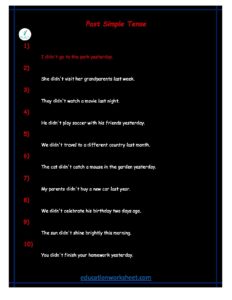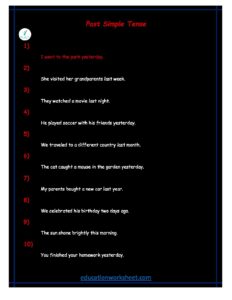8: how to converting Past Simple Tense positive sentences to negative form
how to converting Past Simple Tense positive sentences to negative form
The English language is rich and versatile, offering various ways to express actions and events that occurred in the past. One of the fundamental tenses for discussing past events is the Past Simple Tense. It is commonly used to describe actions, habits, or events that took place and were completed in the past. In this guide, we will explore how to convert Past Simple Tense positive sentences into negative ones.
Understanding the Past Simple Tense

Before delving into the process of converting positive sentences to negative in the Past Simple Tense, it’s essential to grasp the basic structure and usage of this tense.
The Past Simple Tense typically consists of two parts: the subject (the doer of the action) and the verb (the action itself). In positive sentences, the verb is in its base form, often with the addition of ‘-ed’ for regular verbs. For irregular verbs, the past forms can vary and need to be memorized.
Positive Sentence Structure: Subject + Past Simple Verb (Base form or irregular past form) + Object
Example of a positive sentence: She visited her grandmother yesterday.
In the example above, “She” is the subject, “visited” is the past simple verb, and “her grandmother” is the object. The sentence conveys an action that occurred in the past.
Converting Positive Sentences to Negative

To convert a positive sentence in the Past Simple Tense into a negative one, we typically use a helping verb and ‘not.’ The helping verb used in the negative form of the Past Simple Tense is ‘did’ (for regular and irregular verbs) along with ‘not,’ which is often contracted to ‘didn’t.’ Here’s the structure for negative sentences:
Negative Sentence Structure: Subject + ‘didn’t’ (did not) + Base Form of the Verb + Object
Let’s break down the process of converting positive sentences into negative ones step by step:
- Identify the positive sentence in the Past Simple Tense. Look for the subject, past simple verb, and object.
Example (positive sentence): He ate all the pizza.
- Insert the helping verb ‘didn’t’ (did not) before the base form of the verb. Remember that ‘didn’t’ is used for both regular and irregular verbs.
Negative sentence: He didn’t eat all the pizza.
In this example, we inserted ‘didn’t’ before the base form ‘eat’ to convert the sentence into its negative form.
- Maintain the subject and object in their original positions.
- Ensure that ‘not’ is always contracted to ‘n’t’ when used with ‘did.’
how to converting Past Simple Tense positive sentences to negative form

how to converting Past Simple Tense positive sentences to negative form
Common Mistakes to Avoid
Converting positive sentences to negative ones in the Past Simple Tense is relatively straightforward, but there are some common mistakes to watch out for:
- Don’t forget to use ‘didn’t’: Always include ‘didn’t’ as the helping verb. Omitting it can result in grammatically incorrect sentences.
Incorrect: She ate not sushi. Correct: She didn’t eat sushi.
- Maintain the word order: Keep the subject and object in their original positions while inserting ‘didn’t’ and ‘not.’
Incorrect: He didn’t all eat the pizza. Correct: He didn’t eat all the pizza.
- Use the base form of the verb: Remember to use the base form of the verb after ‘didn’t.’
Incorrect: They didn’t went to the beach. Correct: They didn’t go to the beach.
Examples
Let’s explore some more examples to solidify our understanding of converting positive sentences to negative in the Past Simple Tense:
Positive: She studied French last summer. Negative: She didn’t study French last summer.
Positive: They watched a movie yesterday. Negative: They didn’t watch a movie yesterday.
Positive: I visited my grandparents last weekend. Negative: I didn’t visit my grandparents last weekend.
Positive: He played the piano at the party. Negative: He didn’t play the piano at the party.
how to converting Past Simple Tense positive sentences to negative form
Conclusion
Converting positive sentences in the Past Simple Tense to their negative counterparts is a fundamental skill in English grammar. By following the simple structure of adding ‘didn’t’ and ‘not’ before the base form of the verb, you can easily transform positive statements into negative ones. Remember to maintain proper word order and use the correct verb forms. With practice, you’ll become proficient in using the Past Simple Tense in both its positive and negative forms, allowing you to express past actions and events accurately and effectively.
how to converting Past Simple Tense positive sentences to negative form Discover the easy method for transforming Past Simple Tense positive sentences into their negative counterparts. Unlock the secrets of English grammar and elevate your language proficiency. Get started now and enhance your language skills

